
Publisher:
Bonnie King
CONTACT:
Newsroom@Salem-news.com
Advertising:
Adsales@Salem-news.com

~Truth~
~Justice~
~Peace~
TJP
Dec-09-2011 16:02


 TweetFollow @OregonNews
TweetFollow @OregonNews
Debunking the Israelite Myth: Ancient Egypt Knew No Pharaohs
Dr. Ashraf Ezzat Salem-News.comIf you think the stories the Hebrew Bible had told about ancient Egypt was the whole truth … you’d better think once again.And if you believe that ancient Egypt was ruled by pharaohs … then you’d better read the next lines
 King Tutankhamun - please visit Dr. Ezzat's Website: Pyramidion - Politics & Faith – Egyptology & Art |
(ALEXANDRIA, Egypt) - Ancient Egypt knew no Pharaohs, Prologue: The title might sound a bit strange and perplexing, but throughout the following lines I’m going to elaborate, as I unfold this bizarre issue, on the historical reasons why the rulers of ancient Egypt were called kings and not Pharaohs.
“Kings or pharaohs, what difference does it make?” some might argue.
Well, it would make a world of difference if we discovered that, for thousands of years, we’ve been living a myth that we continue to cling to and hold dear as the only irrefutable truth till this very day.
It would make a world of difference if we knew that what took place at that remote period of time in the ancient Near East, particularly in ancient Egypt, has dramatically shaped, over the centuries and through our willful ignorance, the way we live today with all this web of political, ethnic and religious conflict and intolerance, and that only by unraveling the truth and exposing the myths of that past could we untangle this web of antagonism and belligerence we currently endure.
Ancient Egypt, the rise and demise
Egypt, a nation known worldwide as the land of the pharaohs, is so embedded in history you can trace back its culture, spirituality and traditions for thousands of years way long before the world crossed the threshold of civilization; when ancient Egypt was building the great pyramids under a powerful, highly organized central government the world was still crawling out of its prehistoric ages.
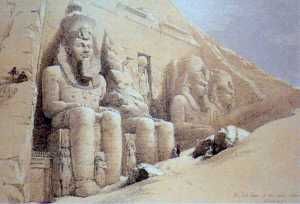 Civilization long shrouded in silence - |
The thing that makes the ancient Egyptian kingdom stand out as a unique civilization in the ancient world history, besides the magnificent legacy of colossal wonders of masonry and engineering and the highly religious texts and moral teachings is the fact that the ancient Egyptians kept a solid and coherent documentation of their chronicles that covered the geo-political, socio-economic, military records and even covered the daily life activities in a way that left not much room for second guessing or speculation.
With the demise of ancient Egypt, the language of that civilization – hieroglyphs – that kept intact and thriving for well over three millennia was eventually declared extinct following the Ptolemaic and Roman period(332 BC- 395 AD)
After that, the ancient Egyptian monuments and texts had been shrouded in sheer silence and neglect and the once great civilization that witnessed the first dawn of human conscience and helped to shape the human code of moral conduct turned into oblivion.
For the following 1500 years too many narratives and stories had been spawned seemingly trying to retell the story of ancient Egypt, not as it actually occurred but through interpretations and perspectives that somehow served the interests of the story tellers.
The story of ancient Egypt, the Israelite version
Of all the narratives that were told about ancient Egypt, the Hebrew Bible is the one narrative that managed to convince the world with its stories of some Pharaoh and Hebrew slaves that, it alone, monopolized the truth about the history of ancient Egypt.
Most of the scholars of the history of the ancient Near East for nearly two millennia relied primarily on the Bible as a scientific reference and in doing so they simply followed what the Hebrew scribes wrote, or better yet tampered with in the history of ancient Egypt and blindly took it for granted.
Scholars of the Biblical ancient history of the Near East and in the absence of the technology of modern archeology, and instead of excavating the earth and digging out the hidden truth, they simply resketched the landscape and chronicles of that remote period of time following whatever signs they encountered within the confines of the Bible pages.
This is how the world got to recognize Egypt as the land, according to the Hebrew’s alleged narrative, where pharaohs brutally reigned and enslaved the ancient Hebrews and also as the land that witnessed the alleged devastating ten plagues, the parting of the sea and the epical exodus of the Israelites from Egypt.
So whenever Egypt was mentioned during the last two thousands of years, the word pharaoh would simultaneously pop up in the discourse thus adding more deluding power to the Hebrew and Biblical designation of the rulers of ancient Egypt as pharaohs.
Ancient Egypt resurrected
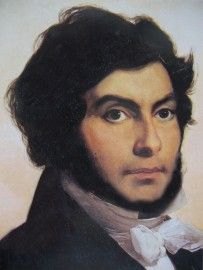 Jean-François Champollion |
It was not before 1822 when Jean-François Champollion, the French philologist managed to decipher the hieroglyphs in his arduous task and breakthrough of translating the Rosetta stone.
Thanks to this brilliant Champollion, the long muted and almost buried under the earth ancient Egypt with treasures of enormous records and chronicles inscribed on the stone and written on papyrus scrolls were resurrected and finally brought back to life.
And what the predecessors thought of as mute masonry covered with some weird scribblings and coffins haunted with some kind of eternal curse began to attract eager historians and modern archeologists who, upon dusting off the ancient artifacts and temple reliefs and inscriptions, and on reading the Egyptian texts they, and for the first time, began to listen to the stone and the papyri uttering the truth about the genuine story of ancient Egypt.
In the mid-nineteenth century the genuine version of the history of ancient Egypt and the Near East was beginning to unravel as its true stories were retold again.
Ironically enough, what the excavated records of ancient Egypt told the modern historians and archeologists was totally different from what the Hebrew narrative said. But what struck historians as a total surprise is the fact that ancient Egyptian records had no mention of any Israelites in Egypt, non whatsoever, while the Hebrew Bible is replete with tales of Egypt, and the more of ancient Egypt texts and inscriptions were unraveled, the remoter from truth the Biblical narrative looked.
Interestingly, and as the historical findings and the non- stop archeological discoveries were in the process of resurrecting the true story of ancient Egypt the Biblical narrative kept on decomposing subjecting some of the dominant Israelite stories, like the exodus, to demolition after it had been scientifically refuted by prominent modern archeologists, many of whom are Israelis and who amongst other Canadian and American Egyptologists now view the story of the Israelites exodus as a mere myth or one of the ancient Israelite’s tales that had been somehow magnified, stretched out and skillfully embroidered by the gifted Hebrew scribes of the Bible over the years.
The ancient Egyptian royal titulary
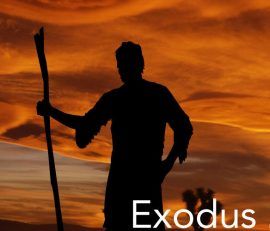 |
If we went back in time and tried to find how the word “Pharaoh” claimed that worldwide popularity and recognition, we would undoubtedly have to stop before the Hebrew landmark story of the exodus from Egypt, the tale of Moses, where he and his people fled the Egyptian kingdom while being hunted down by the army of an alleged tyrant referred to as Pharaoh.
Was pharaoh the name of the Egyptian king, or was it his title or his epithet, that is one thing the Bible had not been clear about. But while such nuance could be appreciated in fictional works, it could never fit into a scientific historical account.
Tracing the etymology and the historicity of that word “Pharaoh” and for an avid reader and researcher of Egyptology who spends almost all of his weekends at the Egyptian museum in Cairo, I stumbled upon the most astonishing discovery. I didn’t discover a new royal mummy nor found the lost tomb of king Akhenaten, I simply found out, contrary to what everybody believed, that the history and the chronicles of ancient Egypt had no mention of pharaohs.
History shows that ancient Egypt only knew kings and sometimes queens but never pharaohs nor any mention of enslavement of Israelites, as a matter of fact; slavery was not a common practice in ancient Egypt and it was introduced into the late dynasties of ancient Egypt only after the Persian and the Roman conquest.
The old kingdom (2686-2181 BC) knew kings such as Djoser, Khufu and Teti , the middle kingdom ( 2055-1650 BC) had kings such as Senusret I and Senusret II and the new kingdom ( 1550-1069 BC) witnessed the topnotch kings such as Thutmose III, queen Hatshepsut, Akhenaten, Tutankhamun and Usermaatre Setpenre ( Ramsses II )
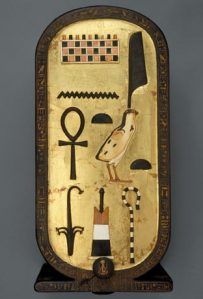 King Tutankhamun royal |
Egyptian kings typically had five names, a Personal name (nomen) which was bestowed upon them at birth and another four names- Horus name, Nebty (“two ladies”) name, Horus of Gold, Throne name (praenomen), that were not given until they took the throne. The final four names were bestowed upon the king to officially commemorate his transformation from a mortal to a deity. The birth name of the king seems to have remained very prominent in the king’s life. It was the birth name that was primarily used in the cartouche and the name by which the king was most commonly known.
The kings’ throne name usually had strong connotations of sovereignty over the upper and lower Egypt and divine relation to the gods Amen or Re. the coronation name inside a cartouche was usually accompanied with the title nesu-bity, “King of Upper and Lower Egypt” and the epithet neb tawy, “Lord of the Two Lands”, referring to upper Egypt and delta regions of Egypt.
For example, king Tutankhamun’s throne name was Tutenkh Amen, which meant the living image of Amen accompanied by the epithet “lord of the two lands” followed by the customary benediction line “life, prosperity and health”
According to the ancient texts and papyri, high ranking officials like high priests, princes, commanders of the army… etc, addressed the king as the ruler of the crowns, beloved of the gods, lord of the diadems, living forever and forever… but never as Pharaoh.
Not so often kings of ancient Egypt were referred to as the magnificent in earth and heaven, lord of crowns and as “the sun in the sky” and this was the ultimate titulary that reflected the ascension of the king to the realm of deities.
Etymology shows that the word pharaoh is the Greek pronunciation of the compound word ” pe-ro” or “pr –aa” which referred to the palace of the king or rather the great house and not necessarily the king himself.
Some argue that during the eighteenth dynasty (sixteenth to fourteenth centuries BC) the title pharaoh was employed as a reverential designation of the ruler as is the case in a letter to Amenhotep IV (Akhenaten), who reigned 1353 – 1336 BC, which is addressed to ‘Pharaoh, all life, prosperity, and health!.
The Great House vs. the White House
But somehow they ignored the fact that this letter was sent from foreign non-Egyptian subordinates who were not entitled to directly address the king of Egypt, the magnificent in earth and heaven by his mere throne name. It was simply not their place to do so. They had to refer to him in a highly dignified and reverential designation. So it was common and accepted from a protocol point of view to refer to the king of Egypt, who presided over the skies like the sun as the one who resides in the great house or the royal palace.
In other words, it was customary and kind of required of those foreign subordinates who were not Egyptian subjects nor well instructed in the Egyptian ancient traditions and culture to refer to the king of Egypt as the great house dweller.
And as we of today refer to the president of the United States and his inner circle of high officials as the white house, in the ancient world and especially amongst the Asiatic foreigners they referred to the mighty king of Egypt and his court of priests and commanders as the great house. And just as the white house is not the title of the president of United States so the “pr – aa” was not the name of the ruler of ancient Egypt.
Never was there a papyrus or an inscription on any wall or pylon of any Egyptian temple that showed the word pharaoh as a reference to the king himself. The name of the king, as the ancient Egyptian traditions decreed, was always enclosed in a royal cartouche.
And to get a grasp of the meaning of “pr – aa” and when ancient Egyptians were inclined to use it, we could only discern that in the following lines from a hymn to the god Ra taken out from the ancient coffin texts or what is known as the book of the dead.
“Homage to thee …
o thou lord of brightness
thou who art at the head
of the great house …
prince of night and of thick darkness …
he comes to thee being a pure soul …
..o, grant thou unto him
His mouth that he may speak therewith,
At the season when there are clouds
And darkness …”
Verses from the ancient Egyptian coffin texts
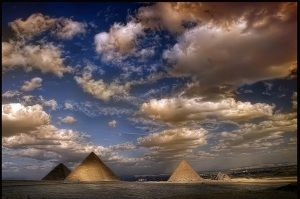 The majestic Pyramids |
As we saw, the ancient Egyptian used to refer to the supreme God as the head of the great house. … That was the epithet of Amun-Re in funerary and religious texts not the king who was used to be designated as the ruler of the two lands and the beloved of gods, etc.
When ancient Egypt was brought back from the dead and resurrected by Champollion’s breakthrough, it was like a prophecy coming true as the ancient Egyptian believed that once his name was uttered once again after his departure he would come back from the dead and live forever as immortal in the afterlife.
That’s why Egyptians cared so much about their funerary texts and coffins.
But on their journey for immortality they somehow, along the way trod on thorny grounds the Israelites covered with made-sacred tales of ancient Egypt and the so-called pharaohs who never ruled except in the Egypt depicted by the Hebrew scribes who made sure it would serve their stories of exodus, wandering in the wilderness and conquest of some promised land, all of which history hardly mentioned or left any archeological trace.
Epilogue
Now let’s go back in time thousands of years ago … long before any crusades, before Jesus Christ, before Alexander the great and even before the alleged tales of the twelve tribes of whom history had not rendered any records… and let us try and re-dramatize the whole thing.
Imagine yourself wandering in the wild desert for weeks in dirty and smelly rags wading through the vast and barren terrains, herding flocks of sheep starving for any sign of green weeds and yourself feeling no less hungry or exhausted under the blazing sun with nothing on your mind except a bite to eat and a shady tree to retire under… and all of a sudden you spot on the distance fields of green, flowing rivers, military garrisons, busy markets, sheltered farmhouses and huge temples .. and at the far background and as the sun was leaving the sky silhouetting the mighty pyramids the smooth white casing of which along with the golden pyramidions glittered as they reflected the sun rays.
This must have been a jaw dropping and day dream-like sight for any shaggy, smelly, itchy and semi-barbaric nomad in the proto-historic time no matter how Jewish or how preferred and meticulously chosen by Yahweh he was.
… Standing barefoot and dwarfed by the colossal royal palace of Egypt’s king, the homeless nomad asked in amazement “what is this?”
“pr – aa” answered one of the royal guards at the entrance of the palace while ordering him to step aside and walk away.
And walk away he did, but on his way back to his tribe in the barren rocky terrains, as he was exiting Egypt, this Hebrew Shepherd could hardly wait to tell his concocted story of the unbelievable land of “Pr – aa”
.. A fictitious story, crammed with fallacies that permeate with a sense of malevolence and envy … but what’s astonishing about this ancient Israelite story is that it still lives, as hallowed and indisputable, with us till this very day.



Quick Links
DINING
Willamette UniversityGoudy Commons Cafe
Dine on the Queen
Willamette Queen Sternwheeler
MUST SEE SALEM
Oregon Capitol ToursCapitol History Gateway
Willamette River Ride
Willamette Queen Sternwheeler
Historic Home Tours:
Deepwood Museum
The Bush House
Gaiety Hollow Garden
AUCTIONS - APPRAISALS
Auction Masters & AppraisalsCONSTRUCTION SERVICES
Roofing and ContractingSheridan, Ore.
ONLINE SHOPPING
Special Occasion DressesAdvertise with Salem-News
Contact:AdSales@Salem-News.com


Terms of Service | Privacy Policy
 Dr. Ashraf Ezzat is an Egyptian medical doctor whose passion has always been writing. He says of all the human-related studies, he finds himself attracted to history. Ashraf stresses that history helps us understand change and how the society we live in came to be.
Dr. Ashraf Ezzat is an Egyptian medical doctor whose passion has always been writing. He says of all the human-related studies, he finds himself attracted to history. Ashraf stresses that history helps us understand change and how the society we live in came to be.




All comments and messages are approved by people and self promotional links or unacceptable comments are denied.
Daryl December 21, 2011 5:53 am (Pacific time)
I don't think so.
http://www.focusonlinecommunities.com/blogs/trueu/2011/12/13/ancient-egypt-knew-no-pharaohs-wrong
DJ: You can believe what you want, but you might read Harper's, March, 2002: ”False testament: archaeology refutes the Bible's claim to history”, before you go any further on this topic.
Daniel December 10, 2011 4:01 pm (Pacific time)
I wonder how come all religions make themselves the chosen ones . I would think the supreme controller would have all the Scriptures confirm one religion or race to be THE CHOSEN , if they really were . Instead every religion makes their own the center of the universe . Are scriptures man made up , or Devine inspiration ? It would seem strange that an all knowing all powerful G.d would limit their glory to one religion . A very knowledgable and informative report , thank you Dr .
Anonymous December 10, 2011 9:50 am (Pacific time)
This article is simply the other side of the coin as per mythmaking. Both the Jews and the other storytellers are creating stories that mix some fact, but then make up suppositional theories that are just that, supposition. The bottom line is, look who prevails today. It is not Egypt, nor any other middle eastern country, they are effectively all 3rd world as per the average citizen. Life is cheap, unless you are elite/connected.
[Return to Top]©2025 Salem-News.com. All opinions expressed in this article are those of the author and do not necessarily reflect those of Salem-News.com.